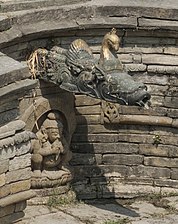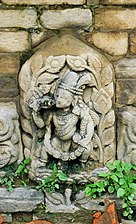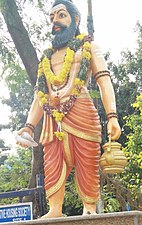Bhagiratha
| Bhagiratha | |
|---|---|
Suryavamsha |
Bhagiratha (

Legend
Bhagirathaprayatnam
King
To commemorate his efforts, the head stream of the river is called
The mythical pātāla where the sage Kapila meditated is identified with the Sāgar Island, at the confluence of the Bhagirathi stream of the Ganges (flowing by Kolkata and revered as Ganga) and the Bay of Bengal. The sea (sam-udra) is called Sāgara in honour of Bhagiratha's ancestor the King Sagara. Kapila's ashrama is located at Sagar Island and hosts the annual Ganga Sagar Mela and bathing rituals on Makara Sankranti day every year.While flowing towards Patala, the Ganga flooded the ashrama of Sage Jahnu. To punish the haughtiness of the goddess, the sage swallowed the river. It was with the insistent entreaties of Bhagiratha that the sage consented to push the river out through his ear, which offered the goddess the epithet Jahnavi.[7][8]
Reign
After completing the funeral rites of his ancestors, Bhagiratha governs once more as king, and his people were wealthy and prosperous under his reign.[9]
The Mahabharata states that the king had a great efficacy of gifting cows, offering hundreds of thousands of cows and their calves to the sage Kohala.[10]
He marries his famous daughter, Haṃsī, to the sage Kautsa, before departing the earth.[11]
Literature
Narada Purana
In the
Bengali literature
In most accounts of Bhagiratha, he is born to his father Dilipa and his unnamed mother in an unremarkable fashion.[citation needed] However, a number of Bengali accounts tell how Dilipa dies without begetting an heir.[citation needed] This story may first be attested in the Bengali-script recension of the Sanskrit Padma Purana; it recurs in the influential, probably fifteenth-century CE Bengali Krittivasi Ramayan, and thereafter in other texts from Bengal such as Bhavananda's Harivansha, Mukundarama Chakravartin's Kavikankanachandi, and the sixteenth-century Ramayana by Adbhutacharya.
Dilipa's lack of an heir troubles the gods, because it has been prophesied that
Gallery
A sculpture of Bhagiratha can be seen beneath the spout of almost every dhunge dhara (hiti) or tutedhara (jarun, jahru, jaladroni), two types of drinking fountain found in the old settlements of Nepal. Bhagiratha is pictured sitting, standing or dancing while holding or blowing a conch. A similar figure can be seen below the gargoyles in some temples in India.[18]
-
Bhagiratha beneath the main spout of Sundhara, Kathmandu, Nepal
-
Bhagiratha on a jarun of Nag Pokhari, Bhaktapur, Nepal
-
Bhagiratha beneath the stone spout of Lamugah Hiti, Bhaktapur, Nepal
-
Bhagiratha on a jarun at Taumadhi Square, Bhaktapur, Nepal
-
Bhagiratha beneath a gargoyle at the Brihadisvara Temple, Thanjavur, India
-
Shiva Gangadhara, Parvati, Bhagiratha (left) at the Ravana Phadi Cave, Aihole, India
-
Bhageeratha statue in Hyderabad, India
See also
References
- ISBN 9788190227254.
The story of Bhagiratha's birth to two women occurs, as far as I know, only in texts produced from the fourteenth century onwards in Bengal. Other manuscripts of the Sanskrit Padma Purana, in the Devanagari script, and other Puranas too relate that Bhagiratha was born in the regular way to his father, Dilipa. As is standard in patrilineages, these latter texts do not mention his mother's name.
- ^ Edits, The Divine (2023-04-22). Padma Purana - A Concise Guide. by Mocktime Publication. p. 10.
- ISBN 978-81-7625-226-3.
- ^ Thomas, Paul (1955). Epics, Myths and Legends of India: A Comprehensive Survey of the Sacred Lore of the Hindus, Buddhists and Jains. D.B. Taraporevala. p. 102.
- ISBN 978-81-208-0597-2.
- ISBN 978-0-8239-3179-8.
- ^ Mankodi, Kirit (1973) "Gaṅgā Tripathagā"Artibus Asiae 35(1/2): pp. 139-144, p. 140
- ^ "The Mahabharata, Book 3: Vana Parva: Tirtha-yatra Parva: Section CVIII". www.sacred-texts.com. Retrieved 2019-04-14.
- ISBN 978-0-85424-048-7.
- ^ The Mahabharata. Bharata Press. 1893. p. 621.
- ISBN 978-81-208-0597-2.
- ISBN 978-81-288-2812-6.
- ^ Ruth Vanita, '"Wedding of Two Souls": Same-Sex Marriage and Hindu Traditions', Journal of Feminist Studies in Religion, 20.2 (Fall, 2004), 119-35.
- ISBN 81-902272-5-4.
- .
- ^ Ruth Vanita, Love's Rite: Same-Sex Marriage in India and the West (New York: Palgrave Macmillan, 2005).
- .
- ISBN 9788121506908, Published by Munshiram Manoharlal Publishers Pvt. Ltd., New Delhi, India, 1995
Sources
- The Ramayana (2001) by Ramesh Menon
- ISBN 0-500-51088-1) by Anna L. Dallapiccola








